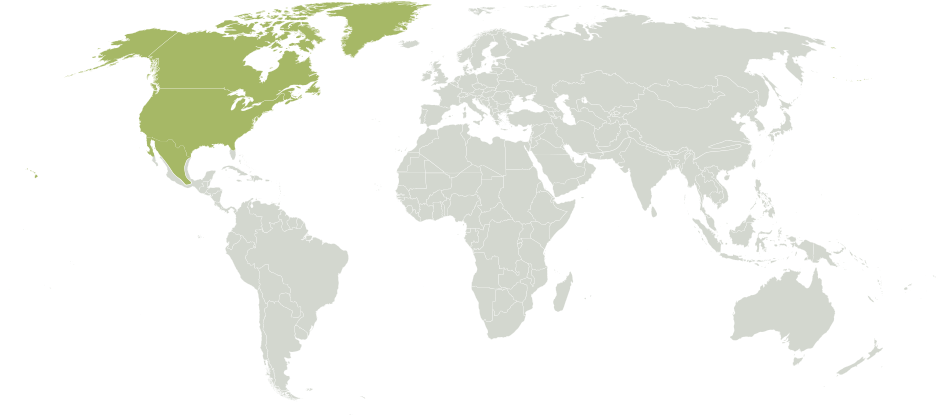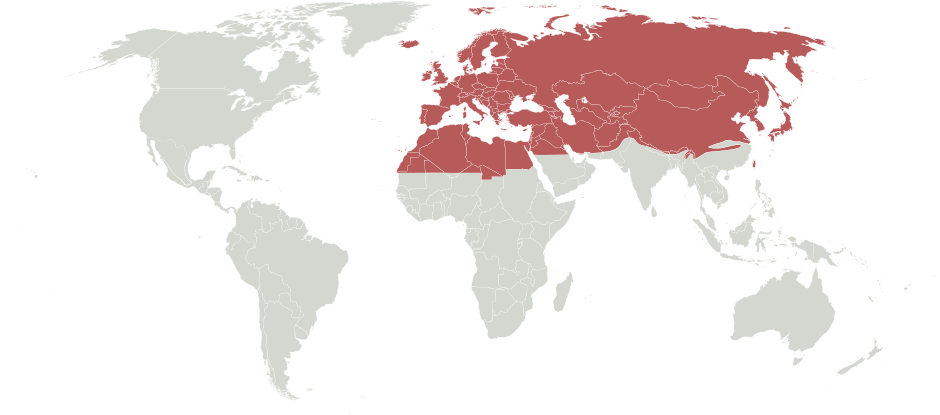Family: Megachilidae
Subfamily: Megachilinae
Tribe: Megachilini
Genus: Megachile Latreille, 1802
Subgenus: Megachile Latreille, 1802
Common name: none
Megachile (Megachile) are “ordinary-looking” bees with black integumentintegument:
a tough, protective outer layer
, primarily pale hair on their bodies, and white apicalapical:
near or at the apex or end of any structure
hair bandsbands:
usually referring to bands of hair or bands of color that traverse across an abdominal segment
on their tergaterga:
the segments on the top side of the abdomen, often abbreviated when referring to a specific segment to T1, T2, T3, T4, T5, T6, or T7 (Michener 2007Michener 2007:
(Michener 2007Michener 2007:
Michener, C.D. 2007. The Bees of the World (2nd ed.). Johns Hopkins University Press, Baltimore and London, 953 pp.). They range in body length from 7–20 mm (Michener 2007Michener 2007:
Michener, C.D. 2007. The Bees of the World (2nd ed.). Johns Hopkins University Press, Baltimore and London, 953 pp.).
(modified from Michener 2007Michener 2007:
Michener, C.D. 2007. The Bees of the World (2nd ed.). Johns Hopkins University Press, Baltimore and London, 953 pp.; Praz 2017Praz 2017:
Praz, C.J. 2017. Subgeneric classification and biology of the leafcutter and dauber bees (genus Megachile Latreille) of the western Palearctic (Hymenoptera, Apoidea, Megachilidae). Journal of Hymenoptera Research 55: 1-54.)
 and often S5S5:
and often S5S5: .
. without apicalapical:
without apicalapical: usually straight in profile.
usually straight in profile. with preapicalpreapical:
with preapicalpreapical:Megachile (Megachile) is similar looking to Megachile (Litomegachile) in their general appearance with overall pale hair and tapered abdomen with white apicalapical:
near or at the apex or end of any structure
hair bandsbands:
usually referring to bands of hair or bands of color that traverse across an abdominal segment
(Michener 2007Michener 2007:
Michener, C.D. 2007. The Bees of the World (2nd ed.). Johns Hopkins University Press, Baltimore and London, 953 pp.). Female M. (Megachile) can be differentiated by their mandibles, which do not have the cutting edges in the third interspace that are present in M. (Litomegachile). Male M. (Megachile) can be separated by the front coxacoxa:
the basal segment of the leg that does not have a spine (Michener 2007Michener 2007:
Michener, C.D. 2007. The Bees of the World (2nd ed.). Johns Hopkins University Press, Baltimore and London, 953 pp.).
Megachile (Megachile) have been observed visiting flowers from multiple plant families, including Apiaceae, Asteraceae, Cactaceae, Campanulaceae, Cardueae, Cucurbitaceae, Ericaceae, Fabaceae, Geraniaceae, Malvaceae, Onagraceae, Ranunculaceae, Rosaceae, Rubiaceae, Solanaceae, and Verbenaceae (Mitchell 1935bMitchell 1935b:
Mitchell, T.B. 1935. A revision of the genus Megachile in the Nearctic region. Part III. Taxonomy of subgenera Anthemois and Delomegachile (Hymenoptera: Megachilidae). Transactions of the American Entomological Society 61(3): 155-205.; Müller and Bansac 2004).
Megachile (Megachile) nest in pre-existing cavities in wood or pithy stems, or excavate their own cavities in sandy soils; some species are flexible in their choice of nest site and will nest in either cavities above ground or in soil (Mitchell 1935aMitchell 1935a:
Mitchell, T.B. 1935. A revision of the genus Megachile in the Nearctic region. Part II. Morphology of the male sternites and genital armature and the taxonomy of the subgenera Litomegachile, Neomegachile and Cressoniella (Hymenoptera: Megachilidae). Transactions of the American Entomological Society 61: 1-44.; Sheffield and Westby 2007Sheffield and Westby 2007:
Sheffield, C.S. and S.M. Westby. 2007. The male of Megachile nivalis Friese, with an updated key to members of the subgenus Megachile s. str. (Hymenoptera: Megachilidae) in North America. Journal of Hymenoptera Research 16(1): 178-191.; Praz 2017Praz 2017:
Praz, C.J. 2017. Subgeneric classification and biology of the leafcutter and dauber bees (genus Megachile Latreille) of the western Palearctic (Hymenoptera, Apoidea, Megachilidae). Journal of Hymenoptera Research 55: 1-54.). Brood cells are usually constructed using small, circular pieces of leaves (Gonzalez 2008Gonzalez 2008:
Gonzalez, V.H. 2008. Phylogeny and classification of the bee tribe Megachilini (Hymenoptera: Apoidea: Megachilidae), with emphasis on the genus Megachile. Thesis: Department of Ecology and Evolutionary Biology and the College of Liberal Arts and Science of the University of Kansas: 1-274.). Megachile (Megachile) montivaga is unique in that it is known to use flower petals instead of leaves to make its nest cells (Michener 2007Michener 2007:
Michener, C.D. 2007. The Bees of the World (2nd ed.). Johns Hopkins University Press, Baltimore and London, 953 pp.; Orr et al. 2015Orr et al. 2015:
Orr, M.C., Z.M. Portman, and T. Griswold. 2015. Megachile ( Megachile ) montivaga (Hymenoptera: Megachilidae) nesting in live thistle (Asteraceae: Cirsium ). Journal of Melittology 48: 1-6.).
Megachile (Megachile) includes 31 species (Ascher and Pickering 2020Ascher and Pickering 2020:
Ascher, J.S. and J. Pickering. 2020. Discover Life bee species guide and world checklist (Hymenoptera: Apoidea: Anthophila). https://www.discoverlife.org/mp/20p?see=Carinulaamp;name=Megachileamp;flags=subgenus :).
There are no known invasives.
Megachile (Megachile) is HolarcticHolarctic:
biogeographic region that encompasses the majority of habitats found throughout the northern continents of the world and can be found throughout North America and Europe, as well as northern Africa and Asia. They primarily occur in cool areas (Michener 2007Michener 2007:
and can be found throughout North America and Europe, as well as northern Africa and Asia. They primarily occur in cool areas (Michener 2007Michener 2007:
Michener, C.D. 2007. The Bees of the World (2nd ed.). Johns Hopkins University Press, Baltimore and London, 953 pp.).

Distribution map generated by Discover Life -- click on map for details, credits, and terms of use.
Ascher, J.S. and J. Pickering. 2020. Discover Life bee species guide and world checklist (Hymenoptera: Apoidea: Anthophila). https://www.discoverlife.org/mp/20p?see=Megachile&name=Megachile&flags=subgenus:
Gonzalez, V.H. 2008. Phylogeny and classification of the bee tribe Megachilini (Hymenoptera: Apoidea: Megachilidae), with emphasis on the genus Megachile. Thesis: Department of Ecology and Evolutionary Biology and the College of Liberal Arts and Science of the University of Kansas: 1-274.
Michener, C.D. 2007. The Bees of the World (2nd ed.). Johns Hopkins University Press, Baltimore and London, 953 pp.
Mitchell, T.B. 1935. A revision of the genus Megachile in the NearcticNearctic:
biogeographical region comprising North America as far south as northern Mexico, together with Greenland region. Part III. Taxonomy of subgenera Anthemois and Delomegachile (Hymenoptera: Megachilidae). Transactions of the American Entomological Society 61(3): 155-205.
region. Part III. Taxonomy of subgenera Anthemois and Delomegachile (Hymenoptera: Megachilidae). Transactions of the American Entomological Society 61(3): 155-205.
Müller, A. and N. Bansac. 2004. A specialized pollen-harvesting device in western palaearctic bees of the genus Megachile (Hymenoptera, Apoidea, Megachilidae). Apidologie 35: 329-337.
Orr, M.C., Z.M. Portman, and T. Griswold. 2015. Megachile (Megachile) montivaga (Hymenoptera: Megachilidae) nesting in live thistle (Asteraceae: Cirsium). Journal of Melittology 48: 1-6.
Praz, C.J. 2017. Subgeneric classification and biology of the leafcutter and dauber bees (genus Megachile Latreille) of the western PalearcticPalearctic:
the largest biogeographic region; consists of Europe, Asia north of the Himalaya foothills, Northern Africa, and the northern and central parts of the Arabian Peninsula (Hymenoptera, Apoidea, Megachilidae). Journal of Hymenoptera Research 55: 1-54.
(Hymenoptera, Apoidea, Megachilidae). Journal of Hymenoptera Research 55: 1-54.
Sheffield, C.S. and S.M. Westby. 2007. The male of Megachile nivalis Friese, with an updated key to members of the subgenus Megachile s. str. (Hymenoptera: Megachilidae) in North America. Journal of Hymenoptera Research 16(1): 178-191.